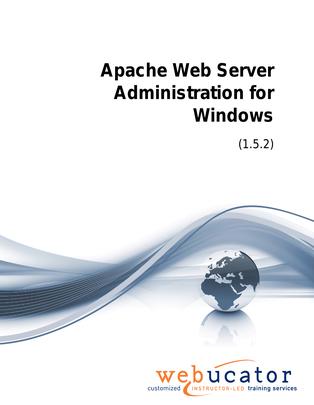
Apache Web Server Administration for Windows Courseware (AHS101)
The primary objective of this course is to prepare administrators for installing, configuring, securing, and performance tuning the Apache HTTP Server on Windows machines. Students will learn how to install and configure the software on Windows and explore the server's directory structure. The course delves into httpd.conf configuration, loading modules, implementing security measures, logging, and configuring directories. Students will also learn about virtual hosts, aliases, and redirects, as well as performance considerations and customizing request/response processing. The course also covers PHP integration and using MySQL with Apache and PHP, along with using mod_proxy and mod_proxy_balance for proxy server functionality.
The course is ideal for system administrators, web developers, and IT professionals seeking to expand their knowledge of Apache web server administration.
Benefits
- Comprehensive Coverage: The course covers all essential aspects of Apache web server administration, from installation and configuration to advanced topics such as performance tuning and proxy server functionality.
- Hands-on Exercises: Practical exercises throughout the course allow students to apply their knowledge and gain confidence in administering Apache web servers for various projects.
- Real-world Applicability: The course teaches practical skills that students can directly apply to their web server administration tasks in a professional environment.
- Security: Students will learn to implement essential security measures, such as SSL, access control, and authentication to protect their web server and its content.
- Performance Optimization: The course covers various performance considerations and provides guidelines for optimizing Apache web server performance.
- Integration with PHP and MySQL: Students will learn how to integrate Apache with PHP and MySQL, enabling them to build dynamic web applications and work with popular platforms such as WordPress.
Outline
- Apache HTTP Server
- The Apache HTTP Server
- Features
- Download
- Windows
- Linux
- Directory Structure
- Apache Directories
- The Role of Each Directory
- bin
- cgi-bin
- conf
- error
- htdocs
- icons
- include
- lib
- modules
- Document Root
- httpd.conf Configuration
- Contents of httpd.conf
- Coding Directives, Containers, and Comments
- Directives
- Containers
- Comments
- Scope of Directives
- Order of Evaluation of Containers
- Making Port Assignments
- Specifying the Document Root
- Including Files
- Modularization and Organization
- Guidelines for Modularization
- Organization
- Verifying the Syntax of httpd.conf
- Updating httpd.conf between Releases
- Securing httpd.conf
- Load Modules
- Dynamic Shared Objects
- The
CoreModule - Static Modules
- Building Modules from Source and Installing from a Package
- Relationship between Modules and Directives
LoadModuleDirective- Using a Module’s Directives
- MIME Types and mod_mime
- Security
- Secure Socket Layer
- Creating a Certificate
- Server Setup
- Access Control
- Host and IP
- Authentication
- Basic Authentication
- Digest Authentication
- How Apache Implements Authorization
- LDAP Authentication and Authorization
- Logging
- Logging Overview
- The Error Log
- The Access, Agent, and Referer Logs
CustomLog- Formatting the Log Record with
LogFormat - Log Rotation
- Configuring Directories
- Directory Containers in httpd.conf
- The Options Directive
- Directory Indexing
IndexOptionsDirectoryIndex- Excluding Files with
IndexIgnore - .htaccess
- Handling HTTP Status Codes with Error Documents
- Location Containers
- Virtual Hosts
- Virtual Host Container
- Setting Up the Virtual Host
- IP-based
- Name-based
- Port-based
- Using Aliases and Redirecting
- Configuring an Alias for a URL
- Redirect
- Using
mod_rewrite
- Performance Considerations
- Adjusting httpd.conf
- DNS Name Lookup
- Logging I/O
- Web Applications
- Network Issues
- Customizing Request/Response Processing
- Handlers and Requests
- Built-in Handlers
- Handler Directives
SetHandlerAddHandlerRemoveHandler- Filters
- PHP
- PHP
- Download and Installation
- Windows
- Linux
- Apache Configuration
- Writing a Basic PHP Web Page
- Using MySQL with Apache and PHP
- WordPress
- Mod Proxy and Mod Proxy Balance
- Apache as a Proxy Server
Required Prerequisites
- Familiarity with general web concepts.
License
Length: 2
days | $70.00 per copy
What is Included?
- Student Manual
- Student Class Files